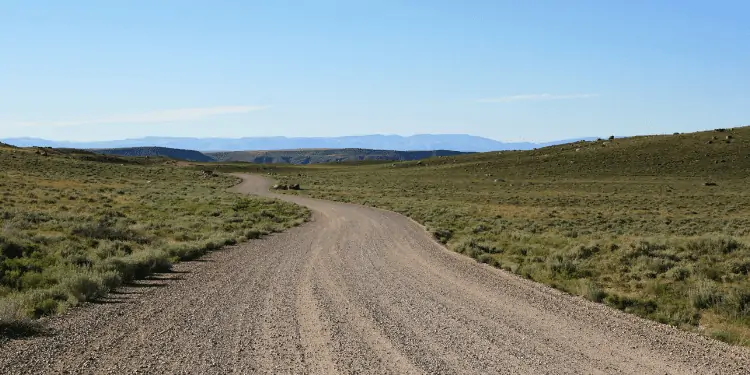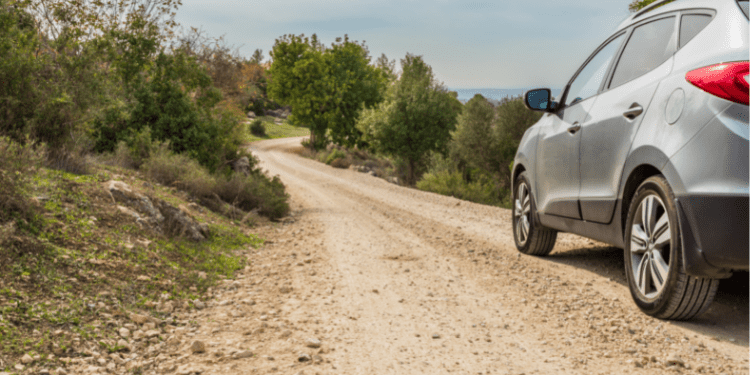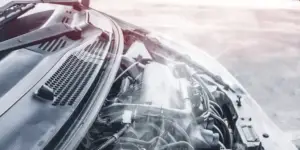The consensus is that gravel – especially loose gravel – is bad for tires. In this post, we’ll explore why it is bad and what steps you can take to minimize the damage caused.
First, here are some interesting facts on the amount of unpaved – gravel roads in the country.
A massive 35% of roads are unpaved, which equates to 1.3 billion miles in total.
As you’d expect, most of these roads are in rural and low-usage roads in farming states.
That’s good news, as the majority of the vehicles on these roads will be work vehicles and trucks that have larger tires and more clearance.
Gravel can be brutal for normal tires, and other components on cars that are not raised as work trucks often are.
Why Is Gravel So Bad For Tires?
Less Tire In Contact With The Road
The crown is defined as the center of the tread and outwards to around 1 inch away from the tire wall. The more contact this area has on the road, the less wear overall occurs. Loose gravel can mean one side of the road is in contact with the road more than the other. This situation is fluid and random. – and changes with each tire rotation as you drive along.
Less Traction
Your car is never fully on an even surface as gravel is loose. Gravel comes in different shapes and sizes resulting in the weight of your car not being evenly distributed over the surface areas of your tires.
Some parts of your tire will be in touch with gravel while other areas are raised a mm or so off the surface.

Less traction means less grip, and less grip means more wheel spinning.
Wheel spinning occasionally won’t cause undue wear on your tire. Still, extended spinning or hard acceleration periods will gradually accumulate the damage and cause your tire to need replacing sooner than it should.
Abrasion
Gravel is abrasive. It’s made of rock and is used on roads due to its resistance to wear and weather.
That’s good news for the authorities but bad news for your tires. Tires are durable but are no contest against rock. Rubber erodes over time on normal roads with no sharp edges, but gravel exacerbates the problem.
Each time a tire travels over a sharp piece of gravel, it’ll cut it slightly. So small, though, that it won’t be visible to the human eye. Over hundreds of miles of driving on gravel, more and more scratches and cuts build up on the surface.
Eventually, this critical mass of cuts will require replacing your tires more often.
Many visitors also read this article: Broken Tire Belts – The Symptoms and Dangers of Bad Steel Tire Belts
Many drivers take a longer route on paved roads than a shorter route on gravel roads. The logic is that it’ll cost more in gas but will save money on the tires – along with other car parts we’ll discuss further on.

ABS Braking On Gravel Roads
I’ve mentioned that wheel spinning can be a problem on gravel, but what about braking?
ABS on gravel roads is fine, although maybe not as effective as doing the ABS’s job manually yourself – this is called cadence braking.
I found a great video of a test on the stopping distances for a car while using ABS, not using ABS, cadence braking, and threshold braking on gravel roads. This test showed that ABS keeps you straight on the road but takes longer to stop. A skilled diver who can cadence brake – pumping the brakes can keep the car in a straight line but also reduce the stopping distance by 33%.
Why not check out the video.
Many visitors also read this article: Guide To Mixing Tires With Different Speed Ratings
Best Tires For Gravel Roads
As all seasons have a deeper tread pattern, they offer better traction on gravel roads than one-season summer tires.
Having deeper treads will also reduce the likelihood of punctures. Not something you want to get on gravel roads as they are usually less traveled, and getting assistance – if needed – may be more difficult.
They’re cheap and easy to come by in retail stores like Walmart.
All-season tires are considered heavy-duty.
Ply rating used to be indicative of the number of layers a tire was made up from. This is no longer the case. Ply rating, or load rating as it is more commonly called, is a number that shows the tire’s robustness. It has nothing to do with tire layers anymore.
Most tires are made up of no more than three plys – even those 12 or 14-ply rated tires. Military vehicles have an 18 rating.
Other Car Parts Damaged By Gravel
Many other parts can be damaged by long-term driving on gravel roads. These include
- Suspension components
- Bodywork chips
- Windshield cracks
- Cracked lights
- Transmission wear.
All the above will be due to gravel hitting areas of your car, but there is another way your car can be damaged too.
Gravel roads do kick up large amounts of dust. Dust won’t have the same visible effects as chipped paint or cracked windshields, but the dust can cause real issues.
- Air filter
This filter’s job is to prevent particles and dirt from getting into the engine’s combustion chamber. Dust disturbed by cars driving over gravel will find its way into the air intake manifold. Once inside, it passes with the air into the filter.
Here two things can happen: The filter either becomes overloaded with dust and doesn’t allow enough air into the engine resulting in a car running rich, or the filter stops blocking the dust and allows it into the combustion chamber along with the air. This is more severe.
Here’s why.
Dust is ground down gravel. Gravel is made of silica. Silica is very abrasive and will erode metal in the engine. It will take time, but eventually, it will degrade engine walls, seals, and pistons to such an extent that the engine performs badly through a lack of compression and oil leaks.
Once this damage is caused, the engine will need remedial work or, at worst, a complete rebuild.
- Paintwork
Your car’s paintwork is made up of various layers. The final layer is a clear coat. It’s transparent and gives your paint that glossy look. Naturally, over time it fades, but dust can speed this up.
If exposed to dust for long periods – especially at the front end of your car if you’re close to a car in front whose tires are kicking up dust – this layer can be removed from your car, giving the paintwork a dull look.
Think of a less aggressive sandblasting situation.
Dust is a known problem on gravel roads, so many states allow suppression of the dust by using chemicals.
Suppression may cause increased corrosion of paintwork and metal components under the car.
A by-product of dust suppression treatments is Calcium Chloride. It occurs when water (rain), oxygen, and sodium – the suppression mix. This creates salt and, when concentrated, has the same properties as saltwater.
Saltwater corrodes metal five times faster than freshwater does and has a real impact on exposed metal.
So, it seems we have dust on gravel roads or suppression treatment. Both of these scenarios cause damage to cars.
Thinking of chains this winter? How Fast Can You Go With Chains on Your Tires?
In Summary
Long-term driving on gravel roads is bad for your tires. The small cuts and rips will mean that tires driven on gravel need replacing sooner than tires driven on asphalt roads.
Some drivers plan routes to avoid them altogether as they feel the increased time spent and the extra gas used is preferable to the damage gravel roads and associated dust or suppression chemicals can cause to their cars.
Drivers that have no choice but to travel on gravel roads should:
- Check tire condition more often.
- Clean the car exterior, especially at the front and around the panels behind the tires
- Make sure mud flaps are in place and in good order
- Check on the air filter and replace it regularly
- Wash underneath more often, especially during rainy periods, to get rid of Calcium Chloride.





![Can Low Oil Cause Rough Idle? [ANSWERED] low-oil-pressure-dash](https://carzaza.com/wp-content/uploads/2023/12/low-oil-pressure-dash-300x150.png)
![Is It Cheaper To Buy All 4 Tires At Once? [ANSWERED IN FULL] sun-causes-tires-to-dry-out](https://carzaza.com/wp-content/uploads/2023/12/sun-causes-tires-to-dry-out-300x150.png)






